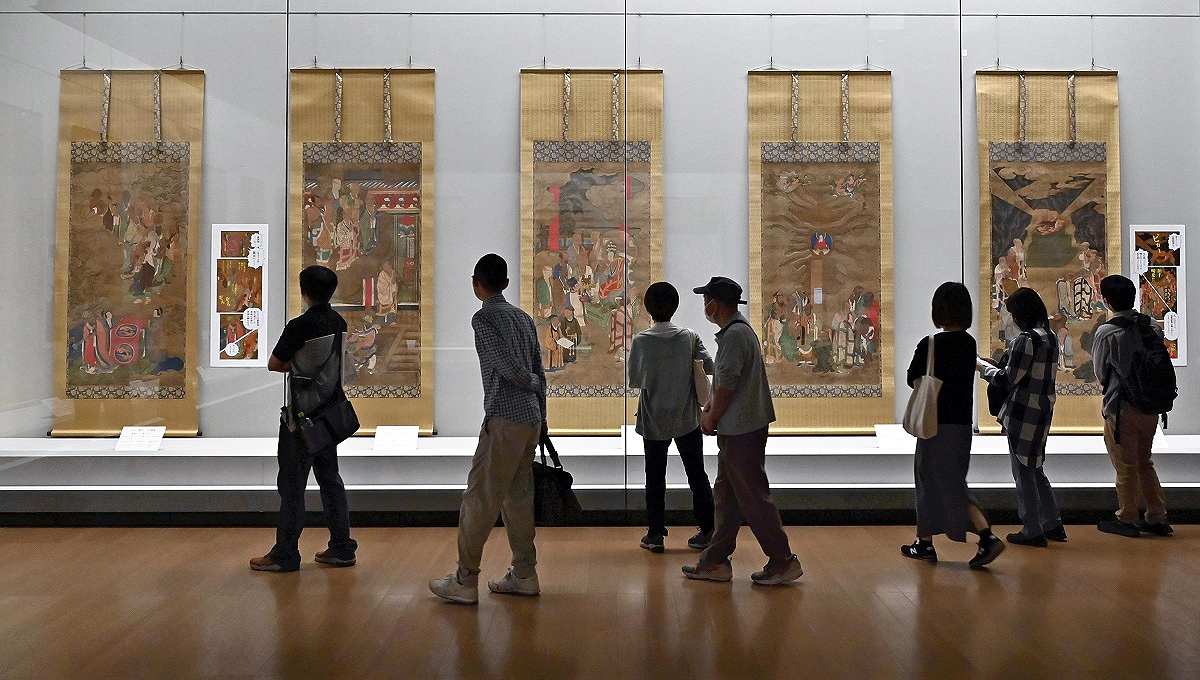Mincho Identified as Painter of Centuries-Old ‘500 Arhats’; Name on Wooden Stick Provides Vital Evidence

“The Five Hundred Arhats” paintings are exhibited at Tofukuji temple in Kyoto’s Higashiyama ward after restoration work was completed in November 2022.
6:00 JST, October 21, 2023
The recent discovery of a wooden stick that was used to turn paintings into hanging scrolls has shed dramatic new light on the work of a legendary Japanese artist from the Muromachi period (1336-1573).

The name “Mincho” is seen on the newly discovered jikugi wooden stick, which is preserved at Tofukuji temple.
The stick, called a jikugi, was used for “The Five Hundred Arhats,” a series of paintings designated as important cultural properties. It provides proof that they are works by legendary Buddhist painter Kissan Mincho (1352-1431).
In the process of repairing paintings from the series that are owned by Tofukuji temple in Kyoto’s Higashiyama Ward, one of the city’s major Zen temples, the wooden stick was found to bear Mincho’s name.
The paintings have been attributed to Mincho in the past, but this discovery provides fresh confirmation that the works were produced by the acclaimed painter-priest.
“The Five Hundred Arhats” consists of 50 paintings, each depicting 10 arhats, or disciples of the Buddha. Forty-seven of the paintings are in Japan, of which 45 are owned by Tofukuji temple and two by the Nezu Museum in Tokyo. None of the paintings have a signature, but they have been believed to have been produced by Mincho, based on their style and historical records.
Born on Awaji Island in what is now Hyogo Prefecture, Mincho, a Zen monk at Tofukuji temple, was regarded as a gasei, or an outstanding artist, along with Sesshu. Mincho’s other paintings, including “White-Robed Avalokiteshvara” and “The Thirty-Three Kannon,” in the temple’s collection are designated as important cultural properties. Ernest Fenollosa, an American scholar of Oriental art who recognized and promoted the beauty of Japan in the Meiji era (1868-1912), is known to have been moved by Mincho’s paintings and even dedicated a poem to them.
When the temple repaired the scrolls between 2008 and 2022, it was discovered that a jikugi stick was preserved there. The 108-centimeter stick, made of cedar wood, was dated to the Muromachi period. It bears writing in ink, indicating that Mincho raised funds to purchase painting materials and fulfill his great desire.
Additionally, writing on the back of the paintings reads, “Year 2 of Eitoku,” which corresponds to 1382, more than a year earlier than the previously presumed starting date of production.
“It is no exaggeration to say that Mincho is one of Japan’s leading religious painters. The identification of Mincho as the creator of this masterpiece is expected to advance our research,” said Prof. Toshio Ishikawa of Kyoto Sangyo University, director of the institute researching the temple’s materials.
“The Five Hundred Arhats,” as well as the jikugi wooden stick are part of “Tofuku-ji: Monumental Zen Temple of Kyoto,” a special exhibition at the Kyoto National Museum in Higashiyama Ward, Kyoto. The exhibition runs through Dec. 3. All available paintings from the “The Five Hundred Arhats” will be displayed in four phases, showcasing 14 paintings in each phase. The jikugi wooden stick will be displayed through Nov. 5. Admission fees are ¥1,800 for adults, ¥1,200 for university students and ¥700 for high school students.

Visitors look at paintings from “The Five Hundred Arhats” series at the Kyoto National Museum in Higashiyama Ward, Kyoto, on Oct. 7.
"Culture" POPULAR ARTICLE
-

Van Cleef & Arpels Dazzles with Art Deco Artisanry at Tokyo Exhibit
-

Disney’s ‘Twisted-Wonderland’ Animated Series Puts Villains in Spotlight: New Show Features School Inspired by Classic Disney Films
-

Ayumi Hamasaki’s Shanghai Concert Canceled Day Before Schedule as Part of Beijing Backlash
-

‘The World Masterpiece Theater Series’ Celebrates 50 Years; Animator Looks Back on Creating Anime Classics
-

Popularity of Piggy Banks Across Time and Place Seen at Bank’s Museum of Money Boxes in Hyogo Pref.
JN ACCESS RANKING
-

Tokyo Economic Security Forum to Hold Inaugural Meeting Amid Tense Global Environment
-

Keidanren Chairman Yoshinobu Tsutsui Visits Kashiwazaki-Kariwa Nuclear Power Plant; Inspects New Emergency Safety System
-

Imports of Rare Earths from China Facing Delays, May Be Caused by Deterioration of Japan-China Relations
-

University of Tokyo Professor Discusses Japanese Economic Security in Interview Ahead of Forum
-

Japan Pulls out of Vietnam Nuclear Project, Complicating Hanoi’s Power Plans























